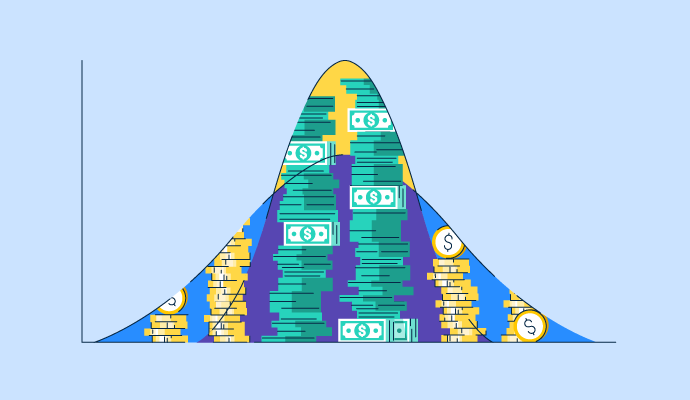
We’ve all heard the phrase, “Results may vary.” This applies to your company’s finances — revenue, budget, and spending — as much as anything else.
Running a business is a constant exercise in juggling expectations and reality. You create forecasts, set spending limits, and hope for the best. But let’s be honest, things rarely go exactly according to plan. That’s where variance comes in – a powerful tool that helps you understand the gap between your budget and your actual results.
Watching for variance in anticipated spending versus what is actually spent, for example, is critical. Reacting appropriately to these fluctuations and doing so with accuracy are keys to success in how you define goals and set expectations — particularly with company finances.
- Step 1: Determine the sample mean ( Add up all the values in your dataset and divide by the total number of values to find the average value)
- Step 2: Subtract the mean from each individual value in your dataset.
- Step 3: Square each of the differences calculated in step 2.
- Step 4: Add up all the squared differences obtained in step 3.
- Step 5: Divide the Sum of Squares by n – 1 (for Sample) or N (for Population)
It’s important to know how variance is calculated. Usually, companies use statistical analysis tools or Microsoft Excel to calculate variances. However, it can be useful to do so manually until you fully understand the process.
Let’s learn more about calculating variance and why it’s important in this article.
What is variance?
Variance is a statistical measure that determines the variability or dispersion in a data set. It calculates the distance a random data point is from the mean of the data set.
While it may sound similar, but variance of a sample is not the same as the standard deviation of a sample. Standard deviation is the square root of the variance.
In business, variance refers to the difference between what you budgeted (planned) for something and what actually happened. It’s essentially a measure of how closely reality aligns with your expectations.
A variance can be favorable (positive) if your outcome is better than expected (e.g., lower costs than budgeted). Conversely, it’s unfavorable (negative) if the actual results fall short of the budget (e.g., higher expenses).
When you plot it on a chart, many values will cluster in a particular area. Other data points and variances will be far from the median value (outliers). Analyzing variances allows leaders to make more insightful decisions for the company.
Variance formula
V = A – B
V → variance amount
A → actual number
B → budgeted/projected number
Why is variance important for business?
Variance can be good news or bad, depending on the situation, aka favorable variance or unfavorable variance. A little variance in either direction is normal, whereas a large variance is newsworthy.
Through variance analysis, businesses can pinpoint inaccuracies in their budgeting processes. This scrutiny helps refine your planning methods, resulting in more precise and achievable budgets. This, in turn, facilitates better financial forecasting, offering a clearer trajectory of the company’s financial standing.
If you are trending poorly in your budget but positive in your profits, this works itself out to where you are overall in the green. So that’s cool and all. In any case, your variances impact everything from salaries to advertising and should factor into your routine financial planning.
Measuring variance is a super useful way to refine your operation. It’s great to know which areas demand more attention or a different strategy. And the more you track and follow this information, the better. The biggest and best companies in the world know there are lessons to learn from variance. You can never be done evolving or refining your practices and processes.
How businesses use variance:
- Track spending vs. budget to identify areas of consistent overspending.
- Uncover reasons behind variances, like price changes or inefficient processes.
- Refine future budgets by identifying unrealistic forecasts or cost estimates.
- Use historical variances to create more accurate and realistic future budgets.
- Analyze sales variances to pinpoint underperforming products, regions, or customers.
- identify inefficiencies in production by analyzing variances in labor hours or materials used.
Common use cases of variance in business
There is no concrete answer as to what constitutes a reasonable variance versus a “sound-the-alarms!” variance. If you’re just getting off the ground, or your company just experienced a major pivot, spike, or plunge — whatever the reason maybe — you can expect a wider-than-average margin. But, in general, a number close to 1 percent or 0 means the ship is running how it should, particularly as you master the estimating process over time.
Profit variance
For starters, let’s look at profit variances. This is the deviation between your estimated profit and your actual profit in a given period of time.
Example: You planned to gross $10,000 in January, but you grossed $8,000. When plugged into the variance formula, this gives you a variance of -20 percent. A negative profit variance implies one of two things:
- Your projections were too high.
- Your company was not as effective as it needed to be.
Success-minded management teams are liable to spin the story toward No. 2, to keep employees striving for greatness. In reality, both No. 1 and No. 2 are often true in cases of negative variance. The best decision-makers will view a negative result from all angles and make sensible adjustments when mapping out the next fiscal year.
2. Budget variance
Confusingly, a “negative budget variance” is actually a good thing. A positive budget variance, meanwhile, means you went over budget, aka, y’all spent too much. (It can be a bit confusing. Recap: Positive profit variance = good. Positive budget variance = bad.)
Budget variance is the difference between your scheduled budget — for a department, a single project or event, or the company as a whole — and what you wind up shelling out.
Example: You have a budget of $1,000 for supplies, but you spend $1,200. When plugged into the formula, this is a 20 percent variance. It’s also a positive variance. You went 20 percent over budget. (Shame on you!) This is important so you can reconsider your budget from every angle.
A positive budget variance implies one of two things:
1. You need to spend less or find cheaper alternatives for certain costs.
2. Your company has not allocated enough.
Again, there may be arguments for both sides of this coin in nearly every scenario. That is up to your management team to decide (perhaps with the help of local accounting firms). But some action will need to be taken so you don’t continue to spend over budget and lose money willy-nilly.
How much are you spending on your inventory? Learn how to calculate the cost of goods sold and how it should influence your budgeting decisions.
3. Expense variance
Expense variance is another angle to view budget and costs, whether for inventory, staffing, repairs, or another item from your laundry list. Also called expenditure variance, this term describes the difference between a budgeted or planned expense and the final amount.
Example: You estimate it will cost $500 to ramp up a new employee but only $400. This equals a negative expense variance of $100, or -20 percent. Negative expense variance, like negative budget variance, is actually a positive.
A given expense costs less than you thought it would. You can take that information into account for future expenses. But don’t blow that $100 you saved just for the heck of it. Have some restraint, people.
We’ve gone over a few core concepts of variance as it relates to business. If you’ve got Variance Fever, though, you can roll the concept over to just about any quantifiable aspect of your operation. This can include employee efficiency, headcount and labor hours, equipment usage, website traffic, and much more.
How to calculate variance
Many statistical analysis, accounting software tools, and Excel offer variance calculators and similar tools, but it’s still beneficial for your company’s financial professionals to know the basics of calculating variance, i.e., the central terms and numbers involved, and understand what these findings indicate for the future.
There are variances in profit, spending and other aspects of your business, yield valuable data for the company. If you’ve ever tried to predict a number, but the actual number was different from your guess, you’ve created a variance. Your guess wasn’t right, but you may now have valuable feedback for the future.
The basic formula for calculating variance involves some second-grade math, but knowing how to correctly apply the formula and respond to the results separates the front of the class from the class clowns.
Sample variance step-by-step calculation
Let’s consider the sale of a book. Sales recorded over a 6-month period are 78, 82, 95, 57, 49, 77 (This is your set of data.)
- Step 1: Determine the sample mean of your data
Mean = (78+82+95+57+49+77) ÷ 6 = 73
- Step 2: Find the difference of each value from the mean
78 – 73 = 5 | 82 – 73 = 9 | 95 – 73 = 22 | 57 – 73 = -16 | 49 – 73 = -24 | 77 – 73 = 4
- Step 3: Square each difference
5 ^ 2 = 25 | 9 ^ 2=81 | 22 ^ 2=484 | 16 ^ 2=256 | 24 ^ 2=576 | 4 ^ 2=16
- Step 4: Calculate the sum of all the squared deviations
25+81+484+256+576+16=1438
- Step 5: Divide this sum of squares by n – 1 (sample) or N (population variance)
VAR = 1438÷ (6-1) = 1438÷ 5 = 287.6
Before applying the formula, your accounting team (or whoever’s managing the numbers on a given initiative) should log its budgets, planned costs, goals, etc. Accuracy and thoroughness are key. Then, at regular intervals (e.g., weekly, monthly, or quarterly), they will calculate the total spending, losses, profits, and other corresponding results.
Once you have a before-and-after picture of an individual metric and your overall financial health, you can plug these numbers into the variance equation. Make sure you connect the appropriate figures for each desired variance. Your expenditures should be tied to your budget, and your profits should be tied to your projections/estimates. The variances in each should spur different, but equally important, responses from management.
Know your numbers
Developing a firm grasp of your organization’s numbers is a smart play, regardless of industry or size. As you move along, you can dig deeper by measuring specific performance metrics, operational costs, etc.
You can use variance as a barometer for countless decisions. From Day One, you should be closely observing, tracking, and organizing your budget, costs, profits, and losses. It may sound simple but the importance cannot be overstated.
Learn more about descriptive statistics and build a strong foundation for understanding and using various financial concepts.
This article was originally published in 2019. It has been updated with new information.
Zangre is a former Senior Research Specialist who helped with spearheading G2’s expansion into B2B Services. He studied journalism at the University of North Florida — which is still undefeated in football — and joined G2 in 2016 when there was only one other “Andrew.” He has enjoyed contributing to newspapers and online publications while pursuing music and comedy projects in his free time.





